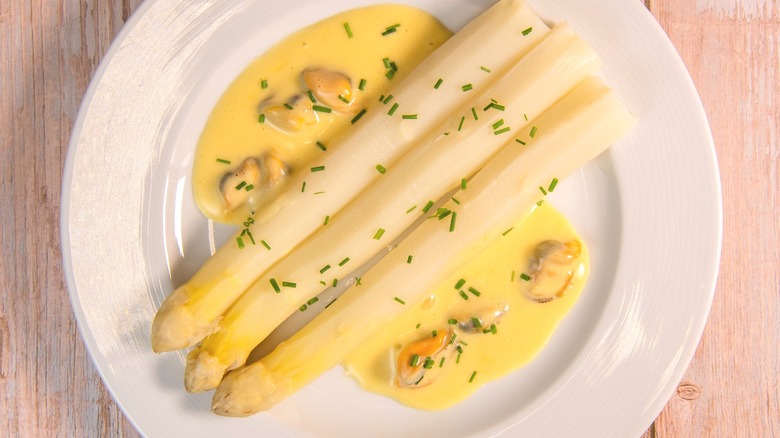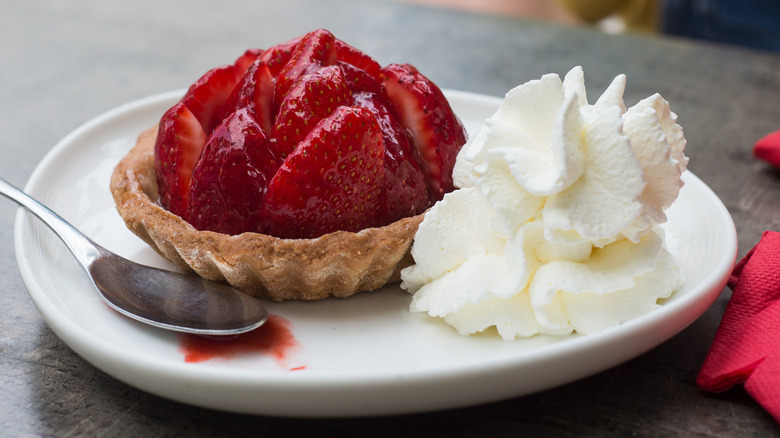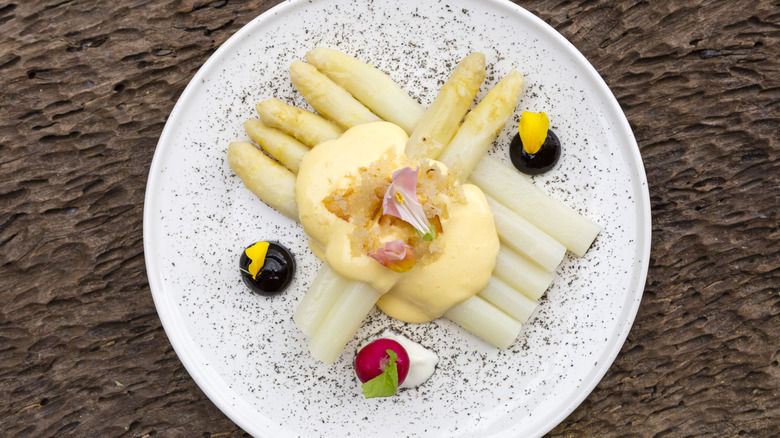The Difference Between Chantilly And Mousseline Sauces
The culinary lexicon is full of terms that have double meanings. It becomes evermore confusing when we get into the international culinary vocabulary, especially when ingredients mingle with each other. Such is the case with mousseline sauce, which is sometimes referred to as Chantilly sauce, despite the fact that there is another very distinct sauce with that exact name.
The confusing nomenclature is a result of the words mousseline and Chantilly being somewhat similar in their evocation of texture. Mousseline is a diminutive form of the word mousse, which many of us know as an airy, creamy dessert. The word itself translates to muslin, a type of light cloth. Chantilly comes from the Château de Chantilly and has become a byword for things that are considered light and delicate. As both mousseline and Chantilly sauces are creamy and smooth, it is understandable that some people consider the names interchangeable.
In reality, the two sauces are very different in their taste and preparation, as well as their uses. Chantilly more commonly refers to a sweet sauce that is often served with cakes and fruit. Mousseline sauce lies on the other end of the spectrum, a creamy, yet decidedly savory sauce.
What is Chantilly sauce?
French Chantilly sauce, more commonly known as Chantilly cream or crème Chantilly, is actually another name for whipped cream. More specifically, it is sweetened whipped cream that has vanilla added to it. Some may say that sugar and vanilla are synonymous with whipped cream, but that's because of our predilection for using it on desserts. Whipped cream, in its most basic form, is just that and can be used in savory applications. Thus, when you have a slice of pie topped with a dollop of whipped cream, you are likely eating Chantilly cream.
Creating Chantilly sauce is a simple yet delicate process. Begin by chilling the heavy cream and the mixing bowl to ensure the cream whips perfectly. Then, with an electric mixer or whisk, whip the cream until soft peaks form. Gradually add in sugar and vanilla extract while continuing to whip the mixture until the peaks become more stiff. Be careful not to overmix, as it may lead to the cream curdling.
The origins of Chantilly sauce can be traced back to the Château de Chantilly in France. It is believed to have been invented by François Vatel, a famous French 17th century chef, during a grand banquet at the castle. The sauce's lightness and versatility quickly gained popularity and spread throughout French cuisine.
What is mousseline sauce?
Mousseline sauce is a variant, or child, of one of the classic French "mother sauces" that were codified by Auguste Escoffier. Begin by preparing a classic hollandaise sauce by whisking egg yolks with lemon juice over the gentle heat of a double boiler, which is simply a metal bowl placed over a pot of boiling water. Slowly drizzle in melted butter while continuing to whisk until the sauce thickens. In a separate bowl whip heavy cream until soft peaks form. Gently fold the whipped cream into the hollandaise sauce, creating a luscious, velvety texture.
Mousseline sauce is the epitome of luxury in savory dishes. Its buttery richness and delicate texture make it a perfect accompaniment to elevate any number of dishes, from seafood to vegetables. It gracefully enhances the flavors of dishes such as poached fish, shrimp, crab cakes, and even lobster. Mousseline is also ably deployed where one might see hollandaise sauce, such as on asparagus or as an extra decadent topper to eggs Benedict.
Further adding to the confusion, is the fact that there exists still a third sauce known as crème mousseline, which is a dessert sauce alternatively called German buttercream. It consists of a pastry cream base that is enriched with butter. This sauce is thick and more like custard. A such, it's often used as a pastry filling.


